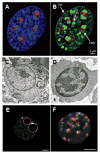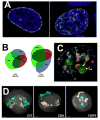The redundancy of the mammalian heterochromatic compartment
- PMID: 26706451
- PMCID: PMC4911328
- DOI: 10.1016/j.gde.2015.10.007
The redundancy of the mammalian heterochromatic compartment
Abstract
Two chromatin compartments are present in most mammalian cells; the first contains primarily euchromatic, early replicating chromatin and the second, primarily late-replicating heterochromatin, which is the subject of this review. Heterochromatin is concentrated in three intranuclear regions: the nuclear periphery, the perinucleolar space and in pericentromeric bodies. We review recent evidence demonstrating that the heterochromatic compartment is critically involved in global nuclear organization and the maintenance of genome stability, and discuss models regarding how this compartment is formed and maintained. We also evaluate our understanding of how heterochromatic sequences (herein named heterochromatic associated regions (HADs)) might be tethered within these regions and review experiments that reveal the stochastic nature of individual HAD positioning within the compartment. These investigations suggest a substantial level of functional redundancy within the heterochromatic compartment.
Copyright © 2016 Elsevier Ltd. All rights reserved.
Figures



References
-
- Beisel C, Paro R. Silencing chromatin: comparing modes and mechanisms. Nat Rev Genet. 2011;12:123–135. - PubMed
-
- Lemaitre C, Bickmore WA. Chromatin at the nuclear periphery and the regulation of genome functions. Histochem Cell Biol. 2015;144:111–122. - PubMed
-
- Padeken J, Heun P. Nucleolus and nuclear periphery: velcro for heterochromatin. Curr Opin Cell Biol. 2014;28:54–60. - PubMed
Publication types
MeSH terms
Substances
Grants and funding
LinkOut - more resources
Full Text Sources
Other Literature Sources

